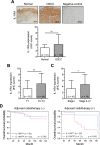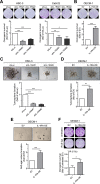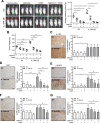IL-1RA promotes oral squamous cell carcinoma malignancy through mitochondrial metabolism-mediated EGFR/JNK/SOX2 pathway
- PMID: 37461111
- PMCID: PMC10351194
- DOI: 10.1186/s12967-023-04343-9
IL-1RA promotes oral squamous cell carcinoma malignancy through mitochondrial metabolism-mediated EGFR/JNK/SOX2 pathway
Abstract
Background: Interleukin-1 receptor antagonist (IL-1RA), a member of the IL-1 family, has diverse roles in cancer development. However, the role of IL-1RA in oral squamous cell carcinoma (OSCC), in particular the underlying mechanisms, remains to be elucidated.
Methods: Tumor tissues from OSCC patients were assessed for protein expression by immunohistochemistry. Patient survival was evaluated by Kaplan-Meier curve analysis. Impact of differential IL-1RA expression on cultured OSCC cell lines was assessed in vitro by clonogenic survival, tumorsphere formation, soft agar colony formation, and transwell cell migration and invasion assays. Oxygen consumption rate was measured by Seahorse analyzer or multi-mode plate reader. PCR array was applied to screen human cancer stem cell-related genes, proteome array for phosphorylation status of kinases, and Western blot for protein expression in cultured cells. In vivo tumor growth was investigated by orthotopic xenograft in mice, and protein expression in xenograft tumors assessed by immunohistochemistry.
Results: Clinical analysis revealed that elevated IL-1RA expression in OSCC tumor tissues was associated with increased tumor size and cancer stage, and reduced survival in the patient group receiving adjuvant radiotherapy compared to the patient group without adjuvant radiotherapy. In vitro data supported these observations, showing that overexpression of IL-1RA increased OSCC cell growth, migration/invasion abilities, and resistance to ionizing radiation, whereas knockdown of IL-1RA had largely the opposite effects. Additionally, we identified that EGFR/JNK activation and SOX2 expression were modulated by differential IL-1RA expression downstream of mitochondrial metabolism, with application of mitochondrial complex inhibitors suppressing these pathways. Furthermore, in vivo data revealed that treatment with cisplatin or metformin-a mitochondrial complex inhibitor and conventional therapy for type 2 diabetes-reduced IL-1RA-associated xenograft tumor growth as well as EGFR/JNK activation and SOX2 expression. This inhibitory effect was further augmented by combination treatment with cisplatin and metformin.
Conclusions: The current study suggests that IL-1RA promoted OSCC malignancy through mitochondrial metabolism-mediated EGFR/JNK activation and SOX2 expression. Inhibition of this mitochondrial metabolic pathway may present a potential therapeutic strategy in OSCC.
Keywords: Cancer stemness; EGFR; IL-1RA; JNK; Metastasis; Mitochondrial metabolism; OSCC; SOX2; Tumor growth.
© 2023. The Author(s).
Conflict of interest statement
The authors declare that they have no competing interests.
Figures








References
Publication types
MeSH terms
Substances
LinkOut - more resources
Full Text Sources
Medical
Research Materials
Miscellaneous

